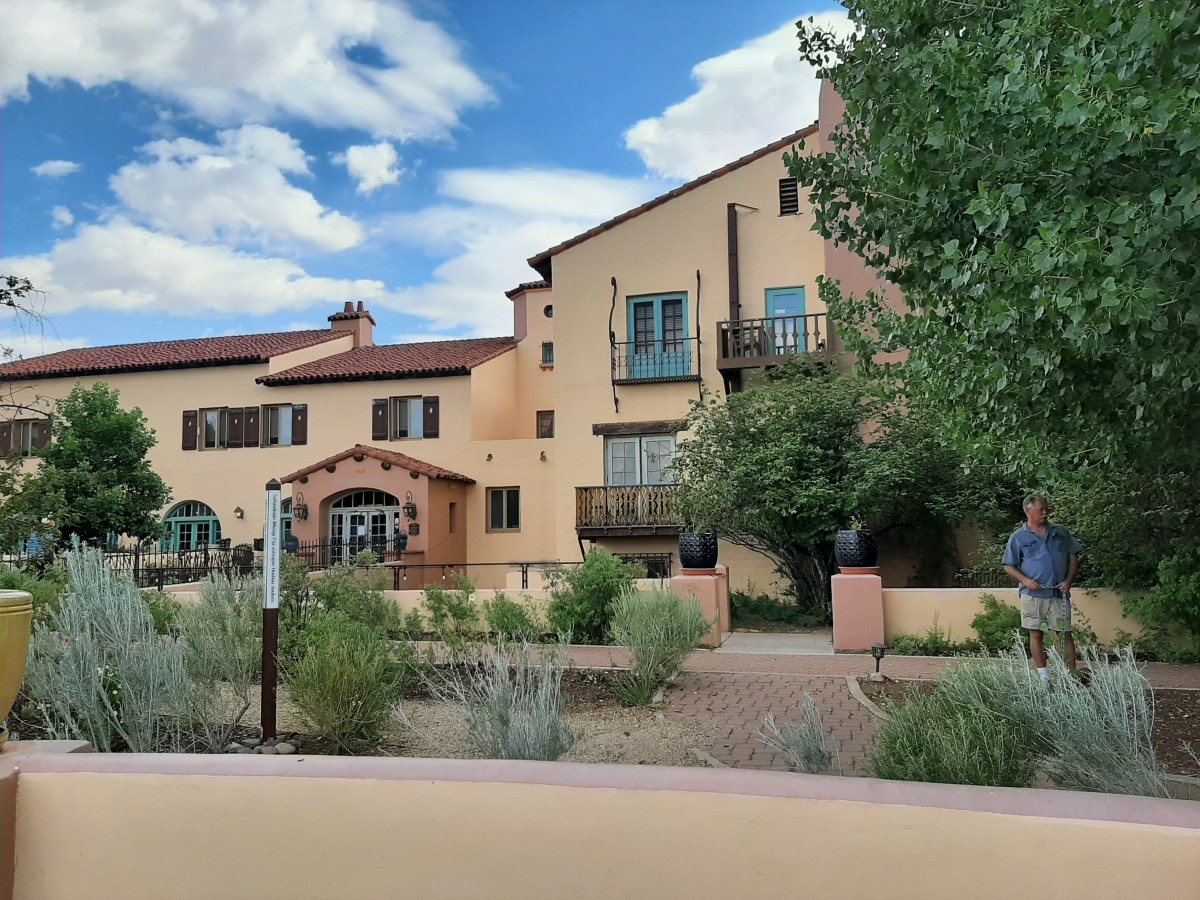Postcards from the Past
Early 1900, Mid 1900 and Latter 1900s postcards
These postcards are from 1901, 1911, 1940 and 1976. Three of them are tied into the Railroad and one into the name Christmas, Florida. Each postcard gives a glimpse into an interesting place or a colorful person.
Fred Harvey Postcard
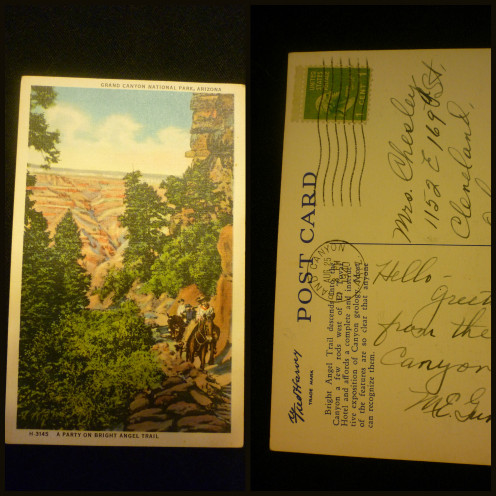
Grand Canyon visit in 1940
To: Mrs. Chesley
Cleveland, Ohio
From: M. E. Gunn
Grand Canyon, Arizona
Postmark August 25, 1940
Grand Canyon, Arizona
Color Print
3 3/8” x 5 3/8”
Material: cardboard
Printed text on back, “Bright Angel Trail descends into the Canyon a few rods West of El Tovar Hotel and affords a complete and instructive exposition of Canyon geology. Most of the features are so clear that anyone can recognize them.”
Hand written text on back, “Hello - greetings from the Canyon ME Gunn”
Picture on the front, “A Party on Bright Angel Trail
Grand Canyon National Park, Arizona
This postcard was from 1910 to the 1920’s when Fred Harvey restaurants were in the Grand Canyon area. Since it is postmarked 1940 it is either a remake of cards or leftovers from that era. Postage on a Post Card in 1940 was 2 cents, but by using a post card with a printed postage amount they were able to mail for 1 cent.
Fred Harvey
This postcard has the Fred Harvey Trademark on the back in the top left corner.
Fred Harvey had a dream and a partnership with the Santa Fe Railroad that helped to civilize the West. Mr. Harvey’s dream was to make fine dining available to the masses. Teaming up with the Santa Fe railroad his dream became a reality with “the Harvey way” of doing things. The railroad would provide the building for the restaurants; furnish free freighting of food, ice, coal, water and transportation of employees. Mr. Harvey provided the equipment, workers and of course, the food. Train crews could eat at Harvey House by using coupons that Mr. Harvey provided for them. The Santa Fe railroad benefited from this arrangement with Mr. Harvey because people soon discovered that they could get great food and service when they traveled the Santa Fe rails.
Civilization of the West
The peak of Fred Harvey and the Santa Fe’s quest to civilize the West was from approx. 1877 to the end of WWII (May 8, 1945) 1877 up to the Great Depression (Aug. 1929 to 1933-34) business was great, but during the Great Depression they had to close several restaurants. Mr. Harvey approached the railroad about having dining cars on the trains. Many of the chefs and waitresses needing work began working on the dining card. The restaurants were beginning to recover when WWII hit and there was a boom for Fred Harvey, the Harvey Girls, the restaurants, and the Santa Fe railroad. The railroads were used to transport our soldiers. “The Harvey way” and the high standards that went along with it were lost during the war because of the great demands on the girls and restaurants. At the close of the war and the arrival of automobiles ended the Fred Harvey restaurants, but the “Harvey Way” lived on in the dining car.
"The Harvey Girls" book
There is a book called, “The Harvey Girls,” by Juddi Morris, copyright 1994. The Era of Fred Harvey and the Harvey girls was definitely an interesting time. The Harvey girls between 1890 and 1945 were a big part of the movement for women rights
El Tovar Hotel, Grand Canyon, Arizona
The El Tovar hotel mentioned on the card is one of the Grand Canyon’s most famous hotels. It was built in 1905 on the South rim of the Grand Canyon. It was formally one of Harvey House Hotels owned by Fred Harvey Company. It is one of only a few of the Harvey House Hotels still in existence today.
Christmas Florida
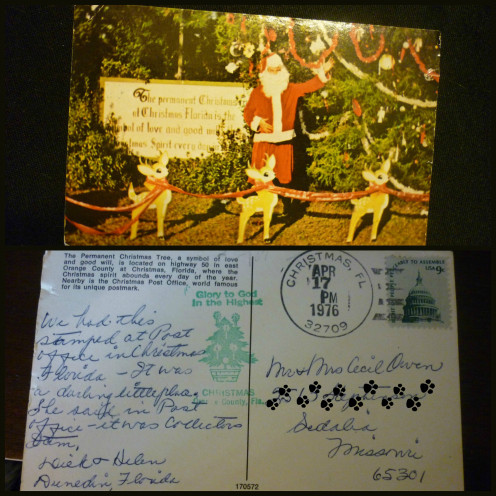
Christmas, Florida
To: Mr. and Mrs. Cecil Owen
Sedalia, Missouri 65301
From: Dick and Helen
Dunedin, Florida
Postmark Christmas, Florida 32709
April 17 1976
The postmark reads “Glory to God in the Highest, Christmas Orange County, Fla.” There is also a tree in a tub with four candles and the stamp is in green.
Postage stamp 9 cents with the U.S. Capital in Washington D.C. on it in grays and blues.
Text on the front of the card, “The permanent Christmas Tree at Christmas, Florida is the symbol of love and good will, where the Christmas spirit abounds every day of the year.”
Printed text on the back of the card, The Permanent Christmas Tree, a symbol of love and good will, is located on highway 50 in east Orange County at Christmas, Florida, where the Christmas spirit abounds every day of the year. Nearby is the Christmas Post Office, world famous for its unique postmark.”
Handwritten text on back, “We had this stamped at the Post Office in Christmas, Florida - It was a darling little place. She said in post office - it was a collector’s items. Dick and Helen Dunedin, Florida."
America 200 years old
Our nation was turning 200 years old on July 4, 1976. The interesting thing about this card is that it is postmarked “Christmas, Florida.” Yes, Virginia there is a Christmas, Florida. It has a population of 1,146 people in 2010. Christmas, Florida was originally called Ft. Christmas because it was built on December 25, 1837 by a force of 2,000 Army soldiers and Alabama volunteers during the Second Seminole War.
"Tex" Wheeler's bronze of Seabiscuit
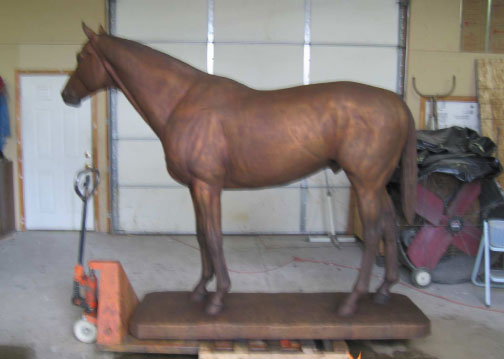
James Huglette "Tex" Wheeler
Christmas, Florida was the home of the American sculptor James Huglette “Tex” Wheeler best known for his bronze sculpture of the racehorse Seabiscuit.
Greetings from Christmas, Florida
This trip for Dick and Helen was 113 miles. They are almost horizontally straight across Florida from Dunedin, Florida. Although, it is April when they get the card it was fun to get a greeting from Dick and Helen and from Christmas, Florida.
Lena with the Slang words
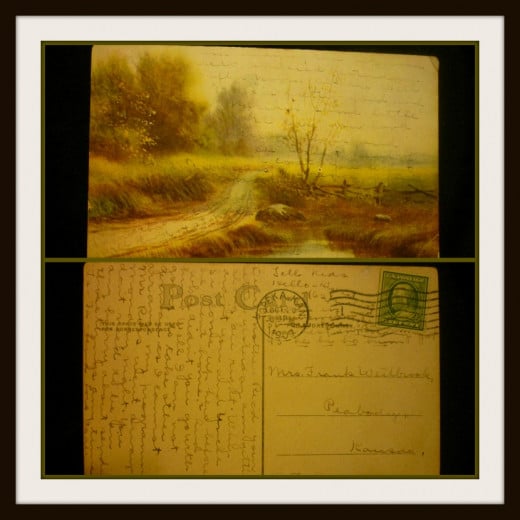
The Slang using Miss Lena
The following is a reprint of a prior postcard blogs, but it ties into the following postcard. Perhaps it is the same person. Their first name is Lena and they are both from Peabody, Kansas only ten year later.
To: Mrs. Frank Westbrook
Peabody, Kansas R.F.D.
From: Lena
Topeka, Kansas
Postmark Topeka, Kan Oct. 20, 1909 6:30 p.m.
1 cent stamp of Benjamin Franklin
“The Turn of the Road”
Color Print
3 3/8” x 5 3/8”
Material: cardboard
We know it after 1901 because it has “Postcard” printed on the back, otherwise there are no clues to its origin.
On the front written along the road, it says, “Follow this and you will find it is Harris St.” Over
“Dear Mother, Rec’d your letter yesterday am getting along all right. Why didn’t you and Uncle Si come up here before he went home. And why didn’t you go with him. Well, I am not goin to take other German as I cannot arrange my programme. Mr. Ross went away Monday night. You don’t need to be in any hurry about sending those things any time. Ta-Ta Lena Love to all.”
Other side of the card, “ Tell kids hello - (62) highest in class also one in Trigonometry 56 on last test and in botany got 93 he hi ho hum.”
She continued writing on the front of the card, “Am studying this afternoon, also studied yesterday afternoon. All are well “Babe” is pretty good and Marian same little girl and can say “look down there” and waits for me to get, “what kind of a coat you want to get?” How is Florence getting on with school?”
There were three Colleges or Universities in Topeka, Kansas in 1909. Washburn Univ. founded in 1865, University of Kansas founded in 1826, and Baker University founded in 1858. Miss Lena possibly Westbrook could have been attending any of these three college/universities. She was doing well in botany and struggling with math. She could have been going to school to become a teacher. During that era there was definitely a demand for teachers.
Ms. Lena was really into slang “he hi ho hum,” and “ta-ta.” Ta-Ta is Swahili and ho hum did not make a hit till around the 1930’s. Not sure where she would have picked these up. Unless, he hi ho hum is Swahili also and she was around someone who spoke Swahili. She was, educated for she knew how to use abbreviations. For the word received was abbreviated correctly. She seems like a happy go lucky type person for both of these slang words, mean “no worries.”
The cover of the postcard could be “The Turn of the Road” which is the title of a book by Eugenia Brooks Frothingham published in 1901. There seems to be very limited information on this book. It could also be a picture similar to one done by the artist John Atkinson Grimshaw of England (1836-1893). He has a picture named “The Turn of the Road” which is landscape and many of his pictures have turns in the road. Although it is not an exact match of that picture titled “The Turn of the Road.” She appears to be well read and up on the latest of things culturally. This girl from Peabody, Kansas.
Want to go fishing? Lena
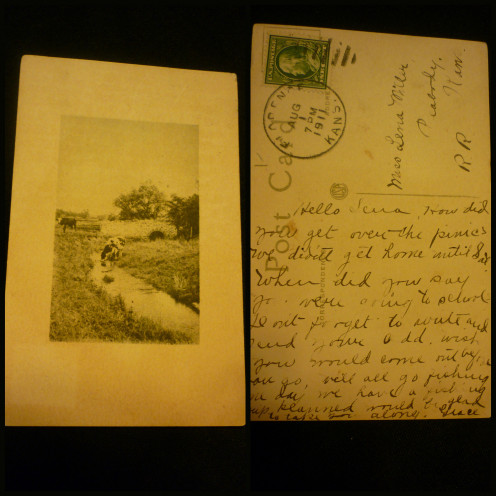
The fishing Miss Lena
To: Miss Lena Miller
Peabody, Kansas
From: Grace
Florence, Kansas
Postmark August 1, 7 p.m. 1911
Stamped with a 1 center Benjamin Franklin stamp
Black and White
3 3/8” x 5 3/8”
Material: cardboard
Handwritten text on back, “ Hello, Lena. How did you get over the picnics? We didn’t get home until Sat. when did you say you were going to school? Don’t forget to write and send your address. Wish you would come out, before you go, we’ll go fishing one day. We have a fishing trip planned would be glad to take you along. Grace”
I’m unsure if this is the same, Lena. She is still a Miss. She is also still connected to schools or schooling. On the prior post card it said “Mother.” So I assumed her last name was Westport. She could have gotten married in these ten years and lost her husband. Her mother may have married again or Lena’s name was never Westbrook, but Miller.
The population of Peabody did not change much from 1901 to 1911 in 1900 there were 1,369 people and in 1910 there were 1,416 people in Peabody. The city in 2010 largest employer is the Unified School District and they have a nice library system. Peabody is a railroad town. H. F. Peabody of the Santa Fe Railroad donated money for a library in 1914. Maybe Miss Lena influenced her community or maybe it is the other way around Miss Lena was influenced by her community.
As the World turns
After each post card there is always a little void because there are so many unanswered questions. Is there really a connection or is it just a huge coincidence? Did they or didn’t they? The ten years did not really change much in Peabody, Kansas, but from 1911 to 1976, there were a lot of changes in our world. We go through WWI and WWII and out nation turns 200 years old.


